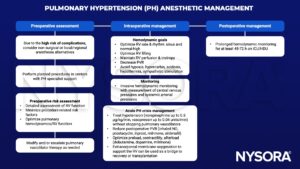Learning objectives
- Describe the definition, clinical classes and treatment of pulmonary hypertension
- Manage patients with pulmonary hypertension
Definition & mechanisms
- Pulmonary hypertension is defined as a mean pulmonary artery pressure (MPAP) >25 mmHg at rest or 30 mmHg on exercise
- The cause of pulmonary hypertension is of critical importance as it defines subsequent treatment
- Patients are classified into five clinical groups:
- Group 1: Pulmonary arterial hypertension (PAH). Idiopathic PAH, connective tissue disease-associated PAH, and congenital heart disease (mainly Eisenmenger syndrome) are the most common subgroups; others include aortopulmonary, HIV, and drug/toxin-induced PAH
- Group 2: PH associated with increased pulmonary capillary wedge pressure (post-capillary PH), due to left-sided heart disease
- Group 3: Lung disease and chronic hypoxia-related PH
- Group 4: Predominantly chronic thromboembolic PH (CTEPH)
- Group 5: PH caused by multisystemic disorders or multiple/unknown mechanisms, including sarcoidosis and hematological conditions
- Adequate coupling of the right ventricle to the pulmonary circulation is essential for maintaining cardiac output in patients with PH
Treatment
- Pulmonary vasodilator therapy is predominantly indicated for the treatment of patients with Group 1 PH and Group 4 PH, although the treatment of choice for CTEPH is pulmonary endarterectomy
- Management of PH in patients with Group 2 and 3 PH is focussed on the underlying heart or lung disease
- Transplantation (usually bilateral lung) remains the ultimate treatment option in PAH when other treatments fail
Management

RV, right ventricle; PVR, pulmonary vascular resistance; ICU, intensive care unit; HDU, high dependency unit.
Suggested reading
- Price L, Brame A, Martinez G, Mukerjee B, Harries C, Kempny A, et al. Perioperative management of patients with Pulmonary Hypertension undergoing Non-Cardiac Surgery: A Systemic Review and UK Consensus Statement. European Respiratory Journal. 2020;56(suppl 64):1467.
- Elliot CA, Kiely DG. Pulmonary hypertension. Continuing Education in Anaesthesia Critical Care & Pain. 2006;6(1):17-22.
We would love to hear from you. If you should detect any errors, email us customerservice@nysora.com

